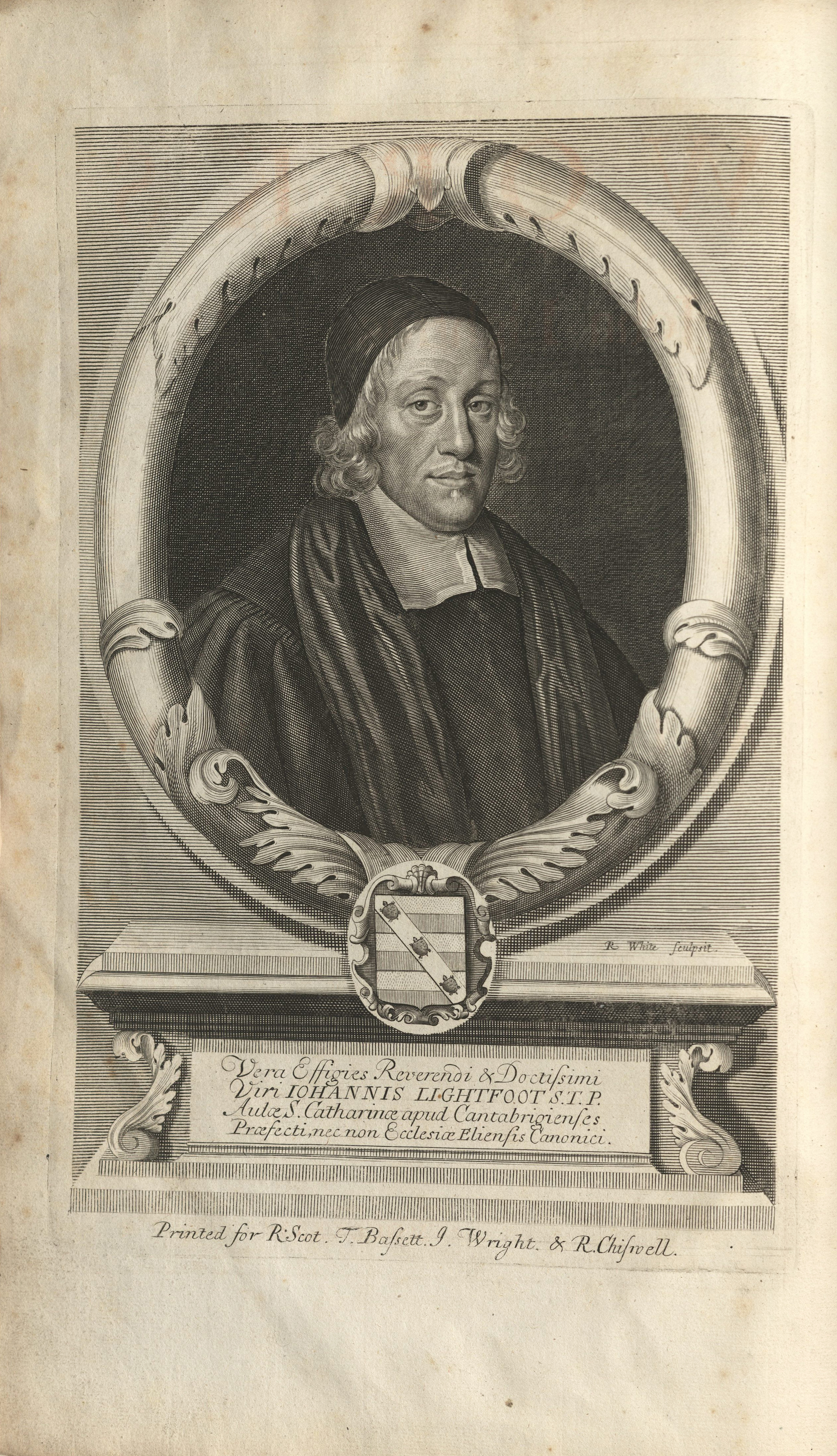Works of the Reverend and Learned John Lightfoot
by Reverend John Lightfoot
| Lightfoot's Works | |
|
Title page from Lightfoot's Works, volume one, George Wythe Collection, Wolf Law Library, College of William & Mary. | |
| Author | Reverend John Lightfoot |
| Editor | George Bright and John Strype |
| Published | London: Printed by W. R. for Robert Scot, Thomas Basset, Richard Chiswell |
| Date | 1684 |
| Language | English, Latin, Greek, Hebrew |
| Volumes | 2 volume set |
| Desc. | Folio (40 cm.) |
| Location | Shelf A-5 |
John Lightfoot was born to a Vicar's family at Stoke-upon-Trent, Staffordshire on March 29, 1602.[1][2] He obtained his bachelor and masters degrees from Christ College in Cambridge, studying under William Chappel who later taught John Milton and Henry More.[3] He joined the church in 1622, settling first as curate at Norton-in-Hales, Shropshire and subsequently becoming chaplain for Sir Rowland Cotton Knight. Knight, a skilled student of Hebrew, inspired Lightfoot to resume his own study of the language.[4] After some time in Shropshire, Lightfoot spent a few years moving around different parishes. He settled at the rectory of Ashley, Staffordshire and stayed there from 1630 to 1642.[5] He moved to London in 1642 and became a Member of the Assembly of Divines at Westminster and minister of the parish of St. Bartholomews.[6] During this time, Lightfoot often disagreed and argued with his fellow members about various Church decisions and protocols.[7] Lightfoot moved to the rectory of Great Munden, Hertfordshire in 1643.[8] A supporter of the parliamentary side in the Civil War, Lightfoot became master of St. Catherine Hall, Cambridge in 1650 and five years later was named vice-chancellor.[9] Lightfoot authored numerous works, first publishing Erubhin, or Miscellanies Christian and Judaicall a study of Jewish customs and the Talmud in 1629.[10] Other titles followed and between 1658 and 1678, he published Horae Hebraicae et Talmudicae, "his most important Biblical study."[11] He died on December 6, 1675 after a short illness.[12] According to one source, "modern Hebraic scholarship can be said to date from Lightfoot. His works such as The Temple (1649–50) display an archaeological, historical, philological, and even anthropological understanding of the biblical past."[13]
Published posthumously, The Works of the Reverend and Learned John Lightfoot gathers together Lightfoot's major publications with a collection of sermons and other minor works. The two volume set edited by George Bright and John Strype includes all six parts of Horae Hebraicae et Talmudicae (1663-1678), the four parts of Harmony of the Four Evangelists (1644-1658), several individual works and more than 40 sermons. The three fold-out maps and two smaller maps were either drawn by Lightfoot himself or with the aid of his instructions.[14] This set remained the most complete collection of Lightfoot's works until the 1822-1825 publication of Whole Works, a 13 volume set edited by John Rogers Pitman.[15]
George Wythe Munford (1803 – 1882), the son of one of Wythe's students, William Munford, twice mentions in The Two Parsons (1884) that in his later life George Wythe had studied Hebrew with a rabbi named Seixas in Richmond, Virginia.[16]
Evidence for Inclusion in Wythe's Library
Wythe's copy survives at the Library of Congress with an 1815 bookplate indicating it was included in the collection sold to the Library by Thomas Jefferson. Volume one has Wythe's signature on the title page, and manuscript notes, throughout.[17] Surprisingly, the set is not listed on Jefferson's copy of the inventory of books he inherited from George Wythe in 1806.
Description of the Wolf Law Library's copy
Rebound in half calf leather, with gilt titles to red labels and five raised bands to the spines. Previous owner's signature on title page of volume two: "Henr Turner: ex AElxis(?)."
Images of the library's copy of this book are available on Flickr. View the record for this book in William & Mary's online catalog. See the table of contents for a complete list of the works included in this set.
See also
References
- ↑ Lightfoot, John (1602–1675)" in Oxford Dictionary of National Biography, accessed March 7, 2023.
- ↑ J. Strype, "Some Account of the Life of the Reverend and Most Learned John Lightfoot D.D.," in The Works of the Reverend and Learned John Lightfoot by John Lightfoot (London: W.R. for Robert Scot, Thomas Basset, Richard Chiswell, 1684): i.
- ↑ "Lightfoot, John (1602-1675)."
- ↑ "John Lightfoot" in Christian Classics Ethereal Library (Accessed December 6, 2018).
- ↑ Strype, "Some Account of the Life," iii.
- ↑ Ibid.
- ↑ Ibid, iii-v.
- ↑ "John Lightfoot."
- ↑ Ibid.
- ↑ "Lightfoot, John (1602–1675)."
- ↑ Ibid.
- ↑ Ibid.
- ↑ Ibid.
- ↑ John Lightfoot, The Works of the Reverend and Learned John Lightfoot (London: W.R. for Robert Scot, Thomas Basset, Richard Chiswell, 1684): Elenchus.
- ↑ "Lightfoot, John (1602–1675)."
- ↑ George Wythe Munford, The Two Parsons; Cupid's Sports; The Dream; and The Jewels of Virginia (Richmond, Virginia: J.D.K. Sleight, 1884), 364, 417.
- ↑ Library of Congress catalog record.
External links
- Table of contents and text at Early English Books Online Text Creation Partnership.
- Read volume one of this work at Hathitrust.


